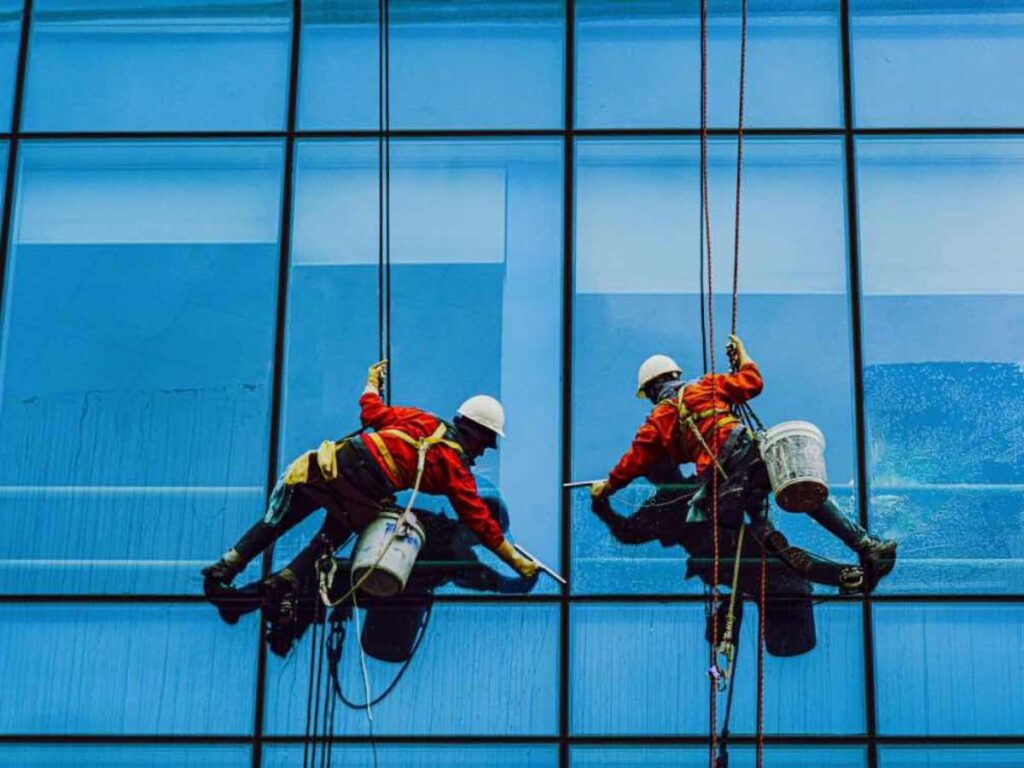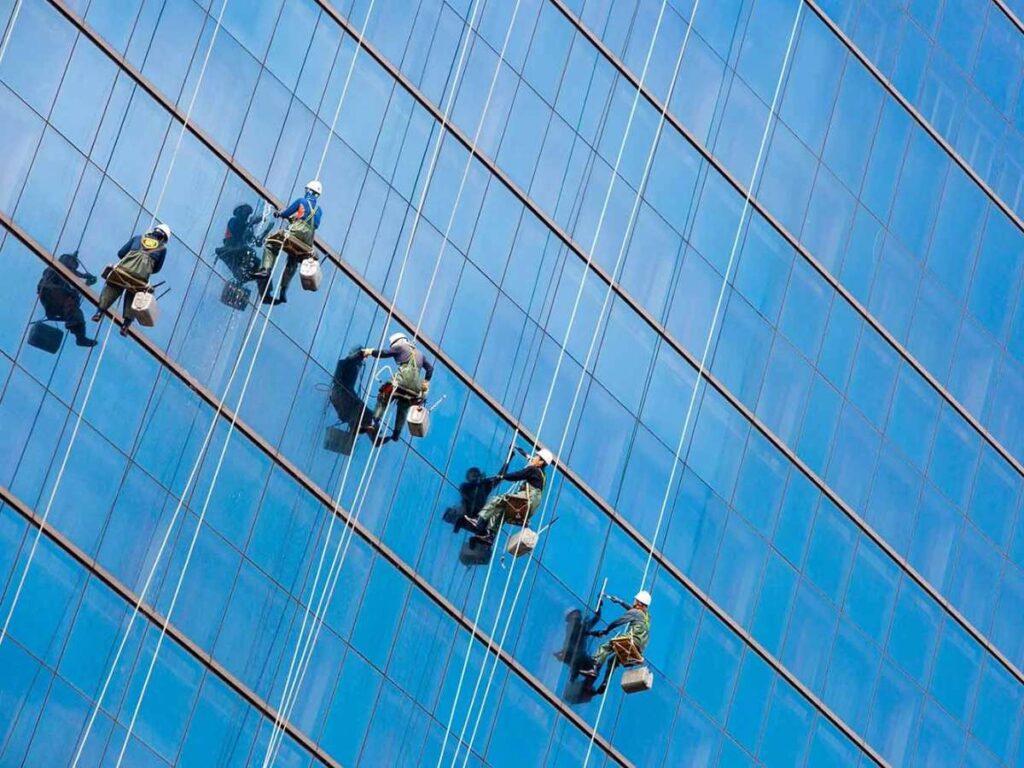“Nothing makes you feel more worried than seeing dirty streaks on windows high up on the 40th floor.” I hear this a lot from hotel managers.
Their concern always comes back to how often skyscraper windows should be cleaned.
As someone who works with property managers and engineering teams on high-rise projects, I see firsthand how cleaning schedules are set and managed.
In this article, I’ll show you how often skyscraper windows are cleaned, what factors change the schedule, and how businesses handle it. You’ll get the answer you need.
Clean windows protect reputation just as much as they protect the view.
So, let’s get started!
1. Why Should You Clean Skyscraper Windows?
I’ve walked into buildings where the glass looked cloudy, and it instantly changed how the place felt. For hotels, offices, or high-rise apartments, dirty windows don’t just block the view, they leave guests and tenants questioning how well the building is managed.
You know, as well as I do, people notice small details. Clean windows show your property is cared for, safe, and worth staying in. And beyond looks, regular cleaning protects the glass itself, saving you from bigger repair costs down the line.

2. Factors That Determine Cleaning Frequency
I’ve learned over the years that no two skyscrapers follow the exact same cleaning schedule. What sets the pace for one property may not work for another. Let’s go through the main factors that usually set the pace.
Location and Surroundings
Where your building stands has a huge impact. Towers near highways, industrial zones, or busy airports attract more dust and pollutants on the glass.
If you’re in a coastal city, salt in the air can leave streaks within weeks. On the other hand, buildings in quieter areas may hold their shine longer, which means fewer cleanings are needed. Vallisco windows are designed to perform well even in challenging environments, helping owners and engineering teams maintain consistent appearance with flexible cleaning schedules.
Weather and Climate
Weather can speed up or slow down how often you’ll call a cleaning crew. In places with heavy rain or snow, dirt and residue cling to windows faster than you’d think.
Dry, windy climates push sand and dust against glass nonstop, and I’ve seen hotels in desert cities double their cleaning schedule because of it. Meanwhile, a city with mild conditions may get away with stretching out the cycle.
Building Height and Architecture
The higher the tower, the more exposure it has to wind, rain, and airborne debris. But design plays a role too. Buildings with recessed windows, ledges, or unusual angles tend to collect dirt in hidden spots that you can’t ignore.
I know modern glass towers require more frequent cleanings simply because of their shape, even though they’re newer and easier to access.
Tenants and Property Use
Your tenants or guests set the standard, whether you realize it or not. A luxury hotel can’t afford to let guests complain about smudged windows, so the cleaning schedule is tight. High-end office spaces also demand spotless glass to impress clients.
Meanwhile, properties used for storage or back-office operations might accept longer gaps between cleanings because appearance isn’t their top priority.
Budget and Maintenance Planning
I’ve been in meetings where everyone agreed the windows should be cleaned monthly, but the budget said otherwise. Window cleaning at skyscraper scale isn’t cheap, and you need to match expectations with available resources.
Some properties settle on quarterly cleaning to control costs while still keeping up appearances. In the end, your financial plan shapes how realistic the schedule can be.

3. Typical Window Cleaning Schedules
From what I’ve seen, skyscraper window cleaning usually falls into predictable cycles. The exact timing depends on location, climate, and building use, but here’s a breakdown you can compare to your own property.
| Schedule Type | Frequency | Best Suited For | Notes |
| Monthly | Every 4 weeks | Luxury hotels, high-end offices | Keeps glass spotless for demanding tenants or guests, but higher cost. |
| Bi-Monthly | Every 2 months | Downtown office towers, coastal properties | Balances presentation with budget; common in busy urban areas. |
| Quarterly | Every 3 months | Standard commercial buildings | Most popular schedule, offers a good mix of appearance and cost. |
| Semi-Annual | Twice a year | Suburban or low-traffic towers | Works if weather is mild and tenant expectations are lower. |
| Annual | Once a year | Warehouses, non-public high-rises | Rare for hotels or offices; usually done only where looks don’t matter as much. |
I always say to my clients that the schedule itself matters less than the consistency. Pick a cycle you can maintain, and your building will always send the right message.
4. Safety Protocols When Cleaning
I’ve watched cleaning crews at work on skyscrapers, and it always reminds me that safety is the real foundation of the job. You and your team can’t afford shortcuts here, one mistake could risk lives and disrupt business. Let’s break down the key protocols I see property managers and contractors follow:
Proper Training and Certification
No worker should step onto a scaffold without proper training. Crews need certifications that prove they understand both safety rules and emergency steps.
I always remind my clients that hiring uncertified workers is like opening the door to liability. Training is the first defense against accidents, and it should never be skipped.
Use of Safety Equipment
Harnesses, ropes, anchors, and guardrails are not add-ons, they are required. On well-run sites, equipment is checked before every cleaning. Vallisco windows are built with frames that provide stable support, giving crews more confidence when working at height. Safer designs support everyone, from managers to cleaning staff.
If you are managing a property, you should always ask to see gear inspection logs. Clean glass matters, but working equipment is what keeps people alive.
Weather and Environmental Checks
Crews should never be out in high winds, lightning, or extreme heat. Rescheduling is sometimes the only safe option, even if it causes delays. Many managers I’ve worked with learned the hard way that ignoring weather risks can shut down a project completely. It is far better to move a date than deal with an accident.
Communication and Emergency Plans
Good communication between crews, supervisors, and property staff can make the difference in an emergency. Radios, daily check-ins, and quick safety meetings keep everyone on the same page. In high-rise work, even a small issue can escalate fast.
You should always ask contractors what their emergency plan looks like. It tells you how ready they are if something goes wrong.
5. 3 Tips When Deciding if Your Windows Need Cleaning
I’ve met plenty of managers who aren’t sure if their windows really need cleaning or if they can stretch the schedule a little longer. You’ve probably had the same question. Here are some simple ways I look at it when I talk with clients:
Tip#1 Listen to Guest or Tenant Feedback
If people start pointing out streaks or haze, you’re already behind. Guests and tenants notice these things quickly. I’ve seen one online review push a hotel into changing its schedule overnight. Pay attention to what people are saying. It saves you from guessing.
Tip#2 Step Back and Take a Look
The easiest test is just to stand back and check the building yourself. I tell managers to cross the street and look up at the glass in daylight.
If it looks patchy or dull, it’s time. That five-minute walk often tells you more than a calendar.
Tip#3 Think About the Season
Different seasons leave their mark on glass. Spring brings pollen, summer dust, and winter road salt. Many of the property teams I work with adjust cleanings around these spikes instead of sticking to a strict date. It makes the schedule match reality.
Conclusion
I started by sharing how hotel managers worry about streaks on glass 40 floors up. That concern is real because windows show how a building is cared for.
We’ve looked at why cleanings matter, what sets the schedule, and how safety shapes the work. The truth is, consistency protects both reputation and glass.
Don’t leave your building’s image to chance.
Contact Vallisco today to learn how durable windows can make maintenance easier!
More Guides and Tips to Explore
For more helpful content, explore our collection of recommended reads:
Still haven’t found what you’re looking for? Don’t hesitate to contact us. We’re available around the clock to assist you.







